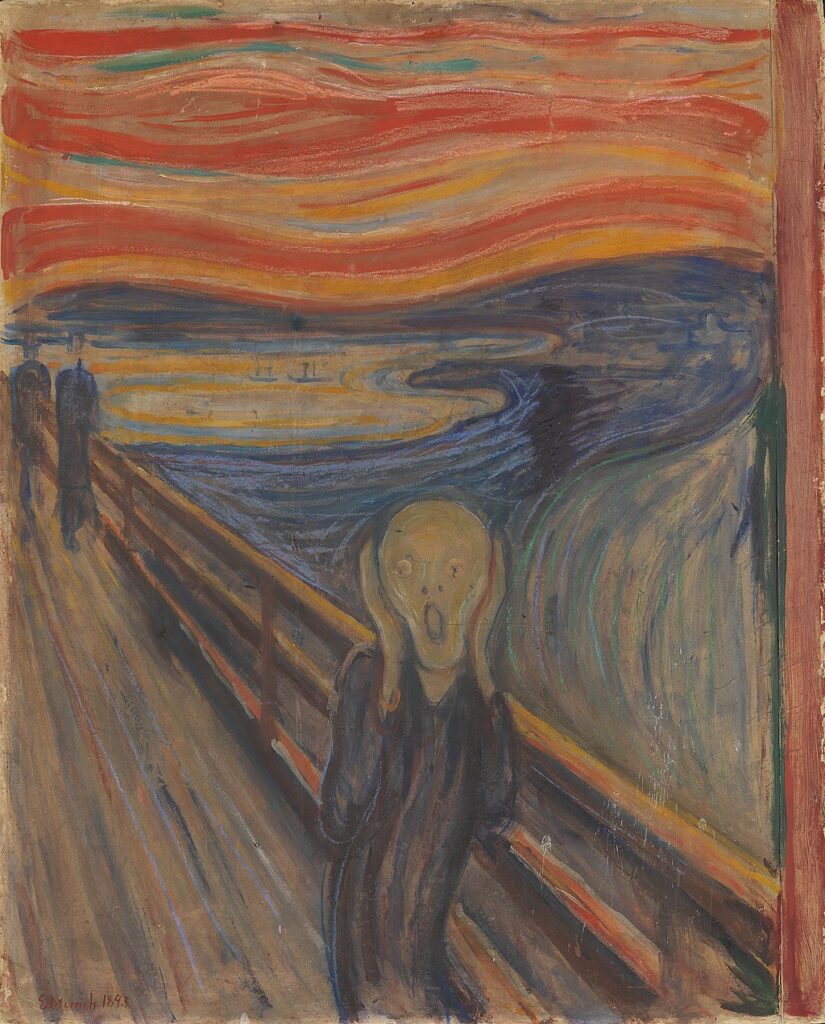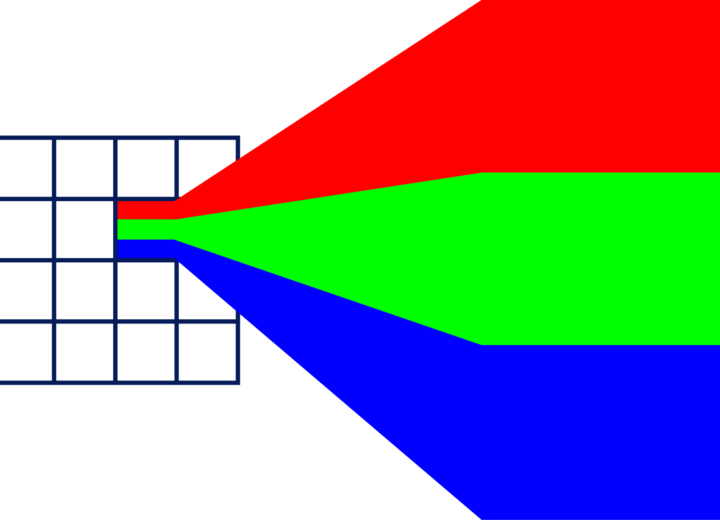In this blog article, we take a look into contemporary Cultural Heritage research and present different digital information sources to analyse a painting. We apply these sources and their analysis techniques to The Scream, the iconic masterpiece by the Norwegian artist Munch. The insights presented in this blog post are useful for conservation, as well as the artistic analysis of the painting. Researchers such as art historians or conservators are committed to gathering new findings about the painting’s materiality and condition as well as the painting composition to reveal new insights that help for both use cases.
To this end, we look for instance into research methods such as hyperspectral imaging to analyse the painting’s surface to identify the used material, as well as the artist’s biography to collect information about the art historian’s background of the painting.
In general, there are multiple versions of The Scream. Munch produced 8 different versions of the painting that reflect his artistic progress, plus previous and following artworks that are strongly related to The Scream. Primarily we present information about the 1893 version of The Scream, but we also take case studies into account that were performed on other versions of the painting. The information about this painting can be divided into three parts. First, we explore general information about the context of the painting, including background information about the artist Edvard Munch, the content and motif of the painting, and what is known about the creation process of the painting. Later, the practical material analysis methodology for paintings using invasive and non-invasive techniques, such as hyperspectral imaging, is presented. In this work, these techniques are explained on a single painting but are also applicable to collections of paintings from the same artist or different artists.
General Information about The Scream
The Scream is probably the best-known painting by Norwegian artist Edvard Munch. As discussed by Ustvedt and Yvenes, the painting is a development of the painting Sick Mood at Sunset. Despair. The Scream was displayed first in the German gallery Unter den Linden under the name of Despair in 1893. The development from Despair to The Scream, as also documented by various sketches, is most noticeable with the humans depicted, especially the respective protagonists of the paintings. In Despair, the depicted characters not only look towards the background of the scenery but are also portrayed in a rather naturalistic style. In The Scream, however, the protagonist has become an abstract and less human-like figure, with an iconic gaze towards the viewer of the painting.
-
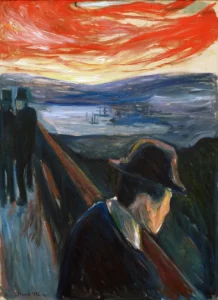
The 1892 version of Despair. Public domain
-
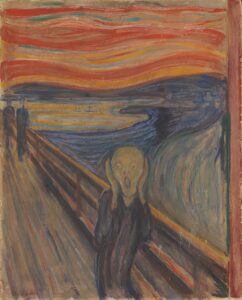
The iconic 1893 version of The Scream. Public domain
The Scream combines, next to the artistic style, several production features typical for Munch. First, the exact production dates of each version are unknown. Munch did not sign his painting with the complete date, hence research debated which versions had been produced first. As stated in 2022 by Ustvedt and Yvenes, there is strong evidence that the version owned by the Nasjonalmuseet was painted in 1893 and the coloured version in the Munch Museum in ca. 1910 or later, indicated by the signing. However, the precise dates of origin have yet to be determined.
Why Munch most likely produced The Scream
In order to identify what may have inspired Edvard Munch to draw The Scream, one must look at the painting’s content in the context of his biography and related work. Edvard Munch (1963-1944) was a Norwegian artist known for his expressionist style. As discussed by Prata et al., Munch’s family background was marked by death and sickness, as his mother and grandfather died from tuberculosis. Also, his grandfather suffered from insanity before his death. Further, Munch’s sister was mentally sick and was sent to an asylum. These hardships, leading to Munch’s belief that he had to turn insane too, are believed to have had a significant influence on Munch’s art as well as leading to the present motifs of blood and melancholy in many of his paintings.
The first evidence of what might have been an important inspiration in terms of scenery and drawn location is a short narrative that Munch wrote in his diary entry of 22nd January 1892:
I was walking along the road with two friends – the sun was setting – I felt a wave of sadness – the Sky suddenly turned blood-red I stopped, leaned against the fence tired to death – looked out over the flaming clouds like blood and swords – the blue-black fjord and city – – My friends walked on – I stood there quaking with angst – and I felt as though a vast, endless scream passed through nature.
Diary entry by Edvard Munch, found alongside Despair, as shown in Aslaksby, text taken from Prata et al.. Note that versions with slight differences exist, e.g., in Ustvedt and Yvenes
This diary entry could hint at an actual event that inspired Munch to craft The Scream. Following Prata et al., the painting may portray a view Munch had while walking around a specific location at the Oslo fjord. There are numerous interpretations and possible reasons why he took a walk there, for example that he could have visited his sister at a nearby mental hospital. Furthermore, The Scream could also be inspired by unsettling sounds from a nearby slaughterhouse, leading to the interpretation that the main protagonist is in fact covering his/her/their ears.
Secondly, as mentioned before, the picture may refer to a location at the Kristiania (now Oslo) fjord. The location portrayed in The Scream can even be identified as a bridge in Ekeberg, now a neighbourhood within the city of Oslo Oslo.
Thirdly, another important aspect is the sky displayed in the painting, which has been investigated by Prata et al.. The authors state that there are again multiple events that could have inspired the red-coloured sky in The Scream: a volcanic sunset or the sunset light specifically visible in southern Norway.
Lastly, for the protagonist, there is the mentioned change in the presentation of the protagonist between Despair and The Scream, as discussed by Rosenblum et al. The final presentation of the protagonist may also have been inspired by the Peruvian mummy Munch saw at the World Fair in 1889, using the mummy as an artistic inspiration for his exploring of raw emotions such as elemental fear and passion.
The materiality of “The Scream“
The identification of materials used in artefacts within the field of Cultural Heritage enables interesting use cases that can be categorised into the following use cases for the conservation and analysis of the artistic creation process of The Scream:
- Conservation
- Investigation and analysis of materials of archaeological, cultural, and historical value, as stated by Fischer and Kakoulli
- Observation and assessment of conservation treatments, as stated by Fischer and Kakoulli, leading to further suggestions for storage and display
- Data, e.g., imaging for documentation and archiving, as stated by Fischer and Kakoulli
- Artistic Creation Process
- Identification of artist-specific materials, e.g., pigments, as shown by Singer et al.
- Analysis of the crafting technique, e.g., the layering of pigments in The Scream, as discussed by Aslaksby
- Generation of findings about the handling of the painting by the artist. , Munch had a rough handle on his paintings, leading to fragile painting surfaces, as shown by Aslaksby
- Placement in the artist’s biography by identifying materials. For instance, there are differences in materiality between the ‚young‘ and ‚mature‘ Munch, e.g., the use of cardboard, as discussed by Aslaksby
- Authorship attribution and identification of forgeries, as stated by Chen et al.
Additionally, the contribution by Deborah et al. shows that the data acquired from material studies can also be used to perform research on the methodology itself, for instance, by introducing a new approach, such as a divergence-based approach to the pigment mapping of a painting.
The analysis of the materiality of an artefact has two focus points:
- The identification of the material, e.g., by analysis of the chemical composition or hyperspectral signal
- Analysis of the layers of the artefacts, e.g. to reveal identify sketches
- Generation of findings of the material mixture, e.g., pure or mixed pigments
- The state of the Material, e.g., by identifying signs of ageing, such as:
- Cracks and fades
- Traces of dust and dirt on the surface
The materiality of a painting such as The Scream can be investigated and analysed in two ways. Firstly, by examining literature from primary and secondary sources about the artistic crafting process. Secondly, by analysing data gathered with invasive and non-invasive techniques directly from the painting.
Textual Sources of Materiality and Techniques in Munch’s Paintings
Prata et al.. state that the materials in Munch’s paintings are hard to identify due to the lack of chronology of his work. However, according to the authors, Munch heavily relied on unprimed canvas or cardboard as a basis and did not use varnishes, but oils, pastels, crayons or pencils that he mixed on the same canvas.
The recent research literature does provide more detailed information about Munch’s materials. According to the Nasjonalmuseet’s online catalogue, The Scream was crafted with Tempera and crayon on cardboard. Further, Aslaksby describes the materials in The Scream, dividing the material into support and the paint. On one side, the cardboard support of the painting is ca. 3.5 mm thick and shows signs of ageing and rough handling. On the other side, the paint contains a matt finish and no protective coat. However, a thin layer of glue or gelatine supports the paint. Munch used the following pigments for The Scream: lead white, zinc white, synthetic ultramarine, viridian, chrome yellow, vermilion and red lead. In the following, the invasive and non-invasive investigation techniques leading to these findings are discussed.
-
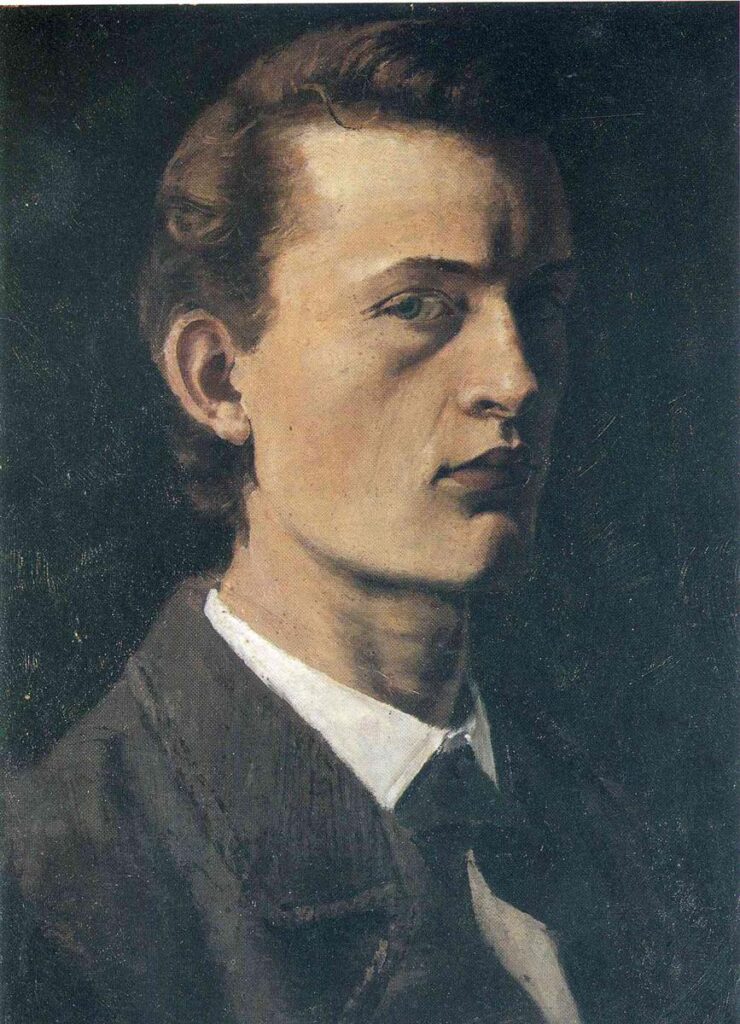
Self-Portrait. 1881 – 1882. Munch Museum, Oslo, Norway. Public domain
Invasive Techniques
Invasive techniques describe the analysis of (micro-) samples taken from the analysis object. One interesting contribution has been made by Levin et al. analysing the nanoparticle composition of the cadmium yellow pigments of the presumably 1903 version of The Scream from the ownership of the Munch Museum. In this case study, a sample has been taken from the 1903 version, and their pigment cadmium sulphide yellow has been analysed because it has also been used by other artists such as Vincent van Gogh. In order to determine the physical state of the pigment, the authors leveraged optical observation, X-ray emission, and X-ray absorption techniques to analyse the painting on a nanoparticle level. These methods enable the identification of the complex microscale structure, leading to information about the particle size, morphology, structure, composition, and the detection of different kinds of cadmium compounds. According to the authors, the knowledge generated from this analysis of the pigments is an important aspect of developing guidelines for appropriate conservation.
However, the extraction of physical samples leads to an array of difficulties. Firstly, with the generation of samples, there is always a risk of damaging the artefact. In the case of artefacts of high cultural value, such as The Scream, and especially for the 1893 version as the most iconic version, the usage of this technique is of high risk and may not be applicable. Furthermore, physical samples are limited to certain parts of the painting or specific materials, as it may only be possible to take samples from some paintings. Secondly, the storage of the samples leads to more effort due to their fragility and this not only has to be carried out professionally but the sample also ages despite professional storage. In addition, storing the taken samples also requires additional effort since it must be done professionally. An additional risk is that the samples may deteriorate with age, even with proper professional storage in place.
Hence, there is very little literature on this approach and much more literature on non-invasive techniques. Still, it can be an interesting approach for identifying the chemical structure of a pigment to identify correct display and storage conditions. In the following, non-invasive imaging techniques for materiality analysis are discussed.
Non-Invasive Imaging Techniques
Due to the previously mentioned difficulties of invasive techniques, non-invasive imaging techniques have been on the rise in the field of cultural heritage. According to Picollo et al., there are several ‚traditional‘ imaging methods, such as ultraviolet-induced fluorescence, infrared reflectography, and X-ray radiography, that, combined with more advanced imaging techniques such as hyperspectral imaging, enable detailed analysis of surface materials, their distribution, and layering. These imaging techniques investigate the interaction between light and matter in different light frequency ranges. This Chapter is focused on multi- and hyperspectral imaging as well as energy dispersive X-ray for The Scream as presented in case of studies by Singer et al., Deborah et al., and Deborah et al. Additionally, hyperspectral imaging offers a technological advantage over ‚traditional‘ methods. All the traditional methods are limited to a specific wavelength range, while, for instance, hyperspectral systems provide a higher number of available bands and, therefore, wider frequency ranges. Also, it is to mention that these systems can be combined in order to supply a sufficient amount of information. However, this subsection provides an overview of multi-/hyperspectral imaging and energy-dispersive X-ray as standalone technologies.
Practical use cases for energy-dispersive X-ray and hyperspectral imaging within the cultural heritage include the identification and state determination of a given material. To this end, Deborah et al. in a case study of the 1893 version, not only identify the material used but also determine the condition of the material by identifying, for example, cracks within a pigment with the use of hyperspectral imaging. The case study by Singer et al. studies the surface of some of the paintings of Edvard Munch, such as The Sick Child or The Scream. They concluded that the pigments in the 1893 version of The Scream were also found in other works by the artist, with details about the pigment composition, including the main pigment and their binder, and also other materials such as bird excrement that indicate that Munch placed his work outside as part of his artistic process. The authors additionally used two methods to investigate the surfaces: energy-dispersive X-ray and polarised light microscopy.
One pattern observed from these case studies is that the researchers mainly investigate the pigments within the painting. Pigments have an important impact on the materiality study, as the usage of pigments and their composition and dyes change over time. Identifying the pigments can help gain interesting findings about a particular work’s time, location, attributes, and circumstances. Hence, the pigment generates knowledge about the artist, the artistic process, and the historical context of the painting. Pigments can occur in pure or mixed form, leading to a significant challenge within pigment identification. This is due to the creation process of the painting, as discussed by Grillini et al. An artist can use several techniques to create a painting, such as alla prima, in which the pigment powders are first mixed and then applied to the canvas or the layering of certain pigments. Hence, the pigment is not the only material that is investigated during pigment identification. The binder of the pigment is also contained within the pigment. Grillini et al. argue that there is a separation of the binder and the pigment that only microscopic instrumentation can detect.
According to Picollo et al., there is no risk of damaging the study object during data acquisition and analysis when using a non-invasive approach, hyperspectral imaging, and in that sense, X-ray fluorescent spectroscopy can be used for long-term data acquisition. As stated by the authors, there are multiple use cases for conservation and preservation, as well as for monitoring, e.g., the efficiency of cleaning processes and restoration interventions for monitoring and evaluating conservation treatments. Further, the authors state that this technology can also be used for long-term data acquisition, which enables studying environmental-related effects, such as microclimatic effects on the painting. For instance, data from hyperspectral imaging, and in a wider sense from other non-invasive techniques such as X-ray fluorescent spectroscopy, could be acquired in certain time intervals.
Identifying and analysing a given material is possible because each material has a unique chemical composition and spectra. A given material can be investigated with the analysis of the interaction of the material with different kinds of radiation.
Referring to Fischer and Kakoulli, the interaction of light with a material surface can be analysed by following the fundamentals of light interaction with matter. Light can interact with surfaces in three different ways as the underlying energy of the light can be transmitted, absorbed, or reflected. Therefore, the energy released during one of the three interactions is measured. Examples of the radiation can be energy-dispersive X-ray or the spectral range of ultraviolet for multispectral imaging, which is explored alongside a technical explanation of the techniques in the following subsections.
-

The Lonely Ones. 1935. Public domain
Hyperspectral Imaging Methodology
Hyperspectral imaging describes a part of spectral imaging, a technology for capturing multiple digital images at various, well-defined optical wavelengths. Goetz et al. state that this technology was initially developed for remote sensing to identify surface materials. This technology aims to acquire as much information as possible about the materiality of an object under investigation. According to Fischer and Kakoulli, the term hyperspectral imaging refers to extending multispectral imaging by expanding the number of bands used in multispectral imaging. Klein et al. provide a clear separation for multi- and hyperspectral imaging by the number of bands, referring to hyperspectral imaging as applications with more than ten bands. Each band provides a specific range of wavelengths.
As mentioned, each material and therefore art-related materials such as pigment analysis have their spectra, a kind of fingerprint. Multi- and therefore hyperspectral imaging refers to analysing the mentioned light/matter interaction, with frequencies inside the visible and invisible range.
Referring to Fischer and Kakoulli, light is mostly described in terms of wavelength. Some wavelength ranges are particularly important for hyperspectral imaging for paintings and are most frequently used in literature. These are the human visual system (VIS) with a wavelength range of 0.4-0.7 μm and technologies like near-infrared (NIR) with μm; and short-wave infrared (SWIR), which are partially not visible to the human eye. Acquiring hyperspectral data within these ranges enables further analysis of materials and pigments.
The study of reflectance can be especially useful for the analysis of art since this can capture both accurate spectral and spatial data. This enables the precise analysis of paintings with the exact location and spectra of the material. In the following, the acquisition of hyperspectral data of painting is described. There are two important factors in hyperspectral image acquisition: the hyperspectral imaging system and the laboratory conditions.
In order to capture hyperspectral images, a particular hyperspectral imaging system with detectors is necessary. The term detector refers to a hyperspectral camera, which can capture images in several wavelengths. According to Picollo et al. for cultural heritage applications, especially camera systems that have a reflectance mode are useful and, depending on the camera sensor, support the visible, near-infrared, and short-wave infrared regions.
There are multiple detectors available for hyperspectral imaging. For further information, Fischer and Kakoulli provide an overview of different multi- and hyperspectral imaging systems based on detectors for different painting types. From this table, one can tell that there are specific imaging systems suitable for pigment detection.
Now, regarding the analysis of the hyperspectral image, there is an array of possible algorithms to investigate the acquired data. In the following, an overview of some of the most important methods, ranging from statistical to automated approaches, is provided. When performing a pigment identification, there are two components necessary: the dataset containing the hyperspectral imaging of the study object and a reference library containing the spectra of the pigments. One exemplary source for the reference library is the Kremer Library.
The data captured by the previously discussed imaging systems are formatted in the form of two spatial dimensions – x and y coordinates – and one spectral dimension, containing the reflectance intensity at each wavelength. Hence, hyperspectral imaging can be viewed as an array of pixels whose values can be analysed for pigment identification.
Once the hyperspectral data from the reference pigment and painting are acquired, one has to do some preprocessing of the data before the actual analysis. This can be done by, e.g., removing certain bands because of noise within the data. Grillini et al., for example, remove the first ten and the last ten bands of their scan, for this reason. There are several algorithms and models available to perform pigment identification tasks. The goal here is to map and group the used materials of the artist according to their spectral similarities, hence investigating the spectral signature of both the pigment and the painting. The hyperspectral scan can be analysed pixel-by-pixel.
Methods based on models like learning or spectral unmixing already follow the idea of automating pigment identification within hyperspectral imaging. While spectral unmixing also applies to a single painting, machine learning needs large amounts of data. In that sense, these methods have certain advantages and disadvantages, e.g., how much data is necessary and, therefore, if artificial data needs to be generated.
Energy Dispersive X-ray
In the contribution by Singer et al., energy dispersive X-ray has been used for the elemental analysis. Energy dispersive X-ray is a variation of the X-ray fluorescent spectroscopy technology, following the same principle to identify materials.
According to Brouwer, X-ray fluorescent spectroscopy describes an analytical method to determine the chemical composition of a given material. The author states that multiple kinds of material can be analysed with this technique, for instance, liquids or powders, and that it is possible to investigate the structure, e.g., layering or thickness as well. Within X-ray fluorescence, a sample is irradiated by X-rays, produced by, for instance, an X-ray tube. The sample then emits fluorescent X-ray radiation, leading to discrete energies. These discrete energies are unique for each given material. Hence, with the measurement of the energies as quantitative analysis, the given material can be determined.
In the context of The Scream research, X-ray fluorescent spectroscopy has been used by Mass et al. to investigate the surface of the 1910 version of The Scream, available from the Munch Museum. In this case study, the authors identified cadmium paints with this technique. In the presented case study by Singer et al., energy dispersive X-ray has been used for elemental analysis, leading to findings about the chemical composition of a given material, such as pigments with binder.
Summary
-
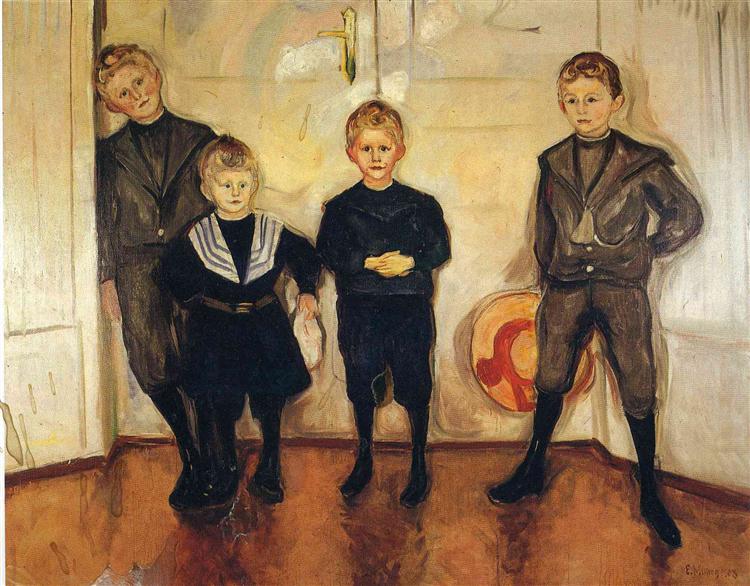
The Four Sons of Dr. Linde. 1903. Public Domain
This blog article provided an overview of the current state-of-the-art of The Scream research. The article presented information from an art historian perspective, as well as from a conservation research-based perspective, providing information ‘about’ and ‘from’ The Scream.
Information ‘about’ The Scream includes the study of primary and secondary art historical sources. These information sources enable the study of the meaning of the painting by taking the artist’s biography and historical context. In the case of The Scream, this section collected information about the creation history of the painting and background information about the artist himself. Munch produced several versions of The Scream, including the related Despair painting, providing a visible change within the artistic style and motif presentation in the painting. Now, the motif can be linked to an actual event in Munch’s life, as shown by Munch’s notes about the Despair painting, hinting at a walk through the Oslo fjord inspiring the portrayed scenery. However, there are multiple interpretations possible of what, for instance, the sky is referring to in detail. Also, the expressionistic style in The Scream may be marked by mental health issues related to the artist’s family background.
Information ‘from‘ The Scream refers to the immediate investigation of materials given on the painting with invasive and non-invasive studies. Invasive studies analyse (micro-) samples taken from the painting. In the case of The Scream, there is very little literature on this approach due to its potential to damage the painting.
Non-invasive techniques analyse the painting materials without damaging the painting. With these technologies, it is also possible to investigate the entire surface of the painting and not only spots as with invasive technologies. In the case of the discussed The Scream version, particularly energy dispersive X-ray and hyperspectral imaging methodology were used to perform an analysis of the materiality of the painting and to identify materials such as pigments. The case studies show that the methodologies can be combined or used as standalone techniques. While Singer et al. used both energy dispersive X-rays and, both case studies by Deborah et al. and Deborah et al., use hyperspectral imaging only with different analysis techniques. As the results of these case studies confirm each other, this non-invasive information alongside the information ‘about’ the painting can be used as a ground truth for further conservation work and art historian research for Edvard Munch and The Scream.

